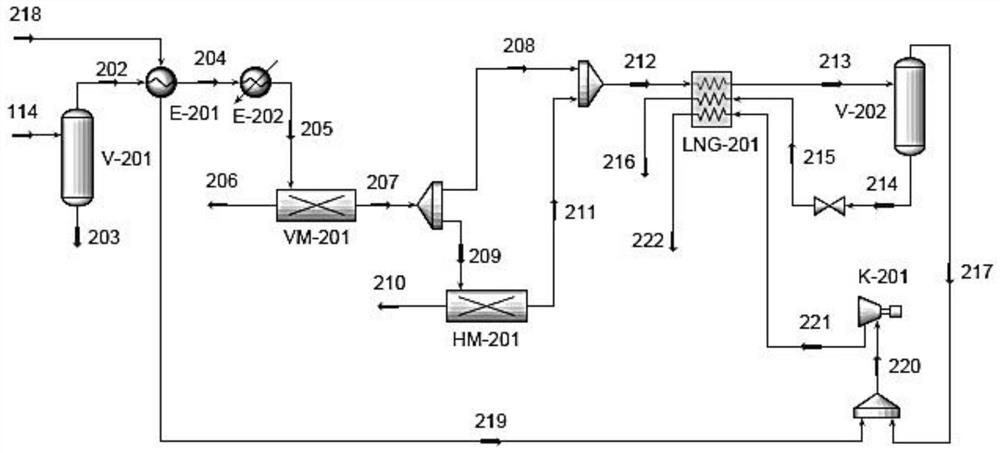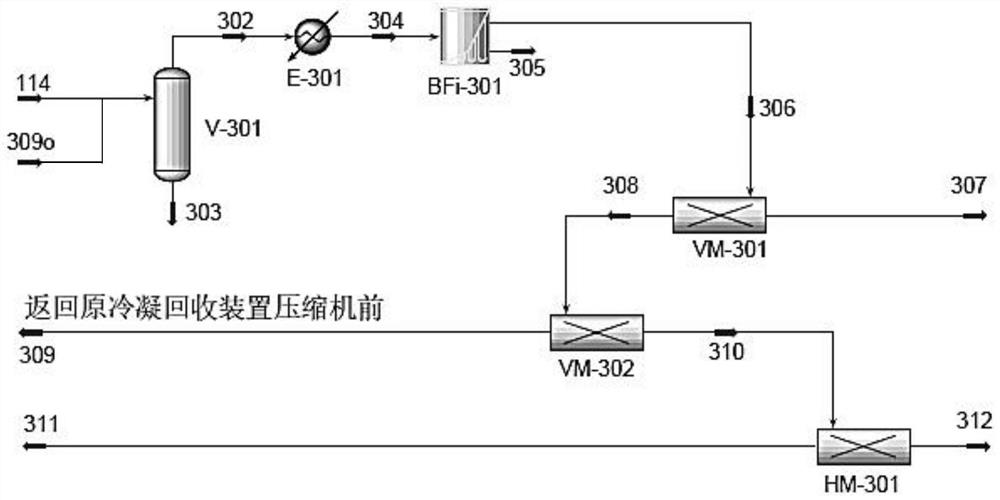Method for recovering tail gas of gas-phase polyethylene device
A recovery method and polyethylene technology, applied in the field of VOCs recovery, can solve the problems of high ethylene recovery rate, sensitive gas composition changes, low investment cost, etc., and achieve high ethylene recovery rate, high equipment reliability, and low equipment investment. Effect
- Summary
- Abstract
- Description
- Claims
- Application Information
AI Technical Summary
Problems solved by technology
Method used
Image
Examples
Embodiment 1
[0035] The schematic diagram of the technological process of this embodiment is as image 3 Show. The exhaust gas 114 from the typical process flow of the gas phase polyethylene process exhaust gas recovery unit first enters the buffer tank V-301, and the liquid mist entrained in the exhaust gas is separated by gravity sedimentation and wire mesh capture. The oil accumulated at the bottom of the tank is discharged regularly through the switch valve at the bottom of the tank. The polymerization tail gas is extracted from the top of the tank, and enters the raw material preheater E-301 to increase the temperature (the operating temperature range of the membrane module is 10-40°C, and the preset temperature is 20°C) to avoid damage to the separation layer of the membrane module by condensation of light hydrocarbons. The heated polymerization tail gas then enters the coalescing filter BFi-301 to further remove fine particles that may damage the membrane modules. Particles and ga...
Embodiment 2
[0045] The organic vapor membrane is a rubbery gas separation membrane, and its preparation method is:
[0046] Step 1: Under the protection of nitrogen, 100kg of vinyl polytrifluoropropylmethylsiloxane and 1300kg of ethyl acetate were stirred at 37°C for 6h, then 19kg of tetramethyl(hydrogen)disiloxane and 4kg of tetramethyl(hydrogen)disiloxane were added. Platinum-based catalyst, 0.2 kg of 1-vinyl-3-butylimidazole bistrifluoromethanesulfonimide salt, 1.9 kg of vinyl phenyl sulfone, stirred at 72° C. for 160 min to obtain a coating solution.
[0047] Step 2, soak 50kgPEI hollow fiber base membrane in 1700kg deionized water, soak at room temperature for 4h, remove and dry, then immerse it in 1500kg coating solution and coat it for 70min; take out the composite membrane coated with coating solution and place In the fume hood, after the ethyl acetate was fully volatilized, the composite membrane was placed in a blast drying oven at 86°C for 4 hours to obtain a rubbery gas separa...
Embodiment 3
[0050] The organic vapor membrane is a rubbery gas separation membrane, and its preparation method is:
[0051] Step 1: Under nitrogen protection, stir 100kg of vinyl polytrifluoropropylmethylsiloxane and 2000kg of ethyl acetate at 50°C for 10h, then add 23kg of tetramethyl(hydrogen)disiloxane and 5kg of Platinum-based catalyst, 0.6 kg of 1-vinyl-3-butylimidazole bistrifluoromethanesulfonimide salt, 3.9 kg of vinyl phenyl sulfone, stirred at 75° C. for 180 min to obtain a coating solution.
[0052] Step 2, soak 50kgPEI hollow fiber base membrane in 2000kg deionized water, soak at room temperature for 5h, remove and dry, then immerse it in 2000kg coating solution and coat it for 100min; take out the composite membrane coated with coating solution and place In the fume hood, after the ethyl acetate was fully volatilized, the composite membrane was placed in a blast drying oven at 90°C for 6 hours to obtain a rubbery gas separation membrane. Others are with embodiment 1.
[005...
PUM
 Login to View More
Login to View More Abstract
Description
Claims
Application Information
 Login to View More
Login to View More - R&D
- Intellectual Property
- Life Sciences
- Materials
- Tech Scout
- Unparalleled Data Quality
- Higher Quality Content
- 60% Fewer Hallucinations
Browse by: Latest US Patents, China's latest patents, Technical Efficacy Thesaurus, Application Domain, Technology Topic, Popular Technical Reports.
© 2025 PatSnap. All rights reserved.Legal|Privacy policy|Modern Slavery Act Transparency Statement|Sitemap|About US| Contact US: help@patsnap.com



